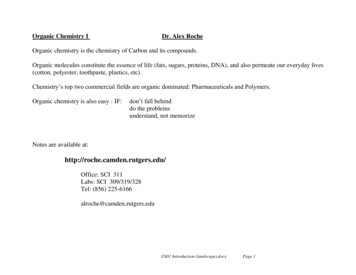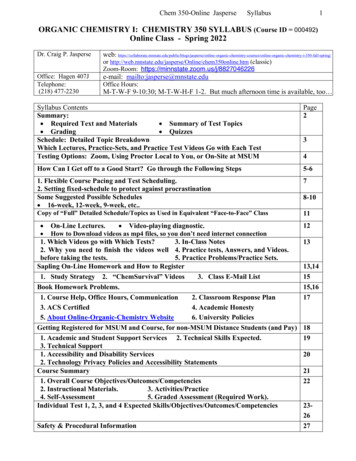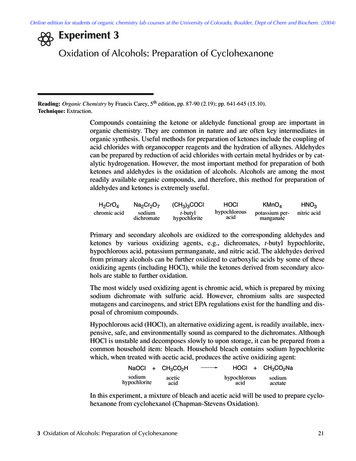
Transcription
Organic Chemistry IDr. Alex RocheOrganic chemistry is the chemistry of Carbon and its compounds.Organic molecules constitute the essence of life (fats, sugars, proteins, DNA), and also permeate our everyday lives(cotton, polyester, toothpaste, plastics, etc).Chemistry’s top two commercial fields are organic dominated: Pharmaceuticals and Polymers.Organic chemistry is also easy - IF:don’t fall behinddo the problemsunderstand, not memorizeNotes are available at:http://roche.camden.rutgers.edu/Office: SCI 311Labs: SCI 309/319/328Tel: (856) 225-6166alroche@camden.rutgers.eduCh01 Introduction (landscape).docxPage 1
Structure of the AtomAtoms consist of: Protons ( ve)Neutrons (neutral)Electrons (-ve)Protons and neutrons are in the nucleus and have similar masses (1800x that of an electron).Atoms with the same number of protons but different neutrons are called ISOTOPES.E.g. 12C (major isotope)13C ( 1%, used in carbon NMR)14C (radioactive, used in Carbon dating)Almost all the mass of an atom is in the nucleus, but it is the electrons that are involved in the chemical bondingand reactions of an atom.Electronic Structure of the AtomElectrons display wave-particle duality.Electrons are located in orbitals around a nucleus, but the Heisenberg Uncertainty Principle tells us that we cannotpinpoint exactly where the electron is.So we use the term ELECTRON DENSITY, which is the probability of finding the electron in a particular part ofthe orbital.ORBITAL: is an allowed energy state for an electron, with an associated probability function that defines thedistribution of electron density in space.Ch01 Introduction (landscape).docxPage 2
Atomic OrbitalsThese are different shells at differing distances away from the nucleus. Each has a principal quantum number (n).As n increases,Shells are further from the nucleusHigher energyCan hold more electronsn 1 can hold 2 electrons, n 2 can hold 8 electrons.Ch01 Introduction (landscape).docxPage 3
First Electron ShellContains the 1s orbital.An s orbital is spherical, so the electron density is only a function of the distance from the nucleus.Ch01 Introduction (landscape).docxPage 4
Second Electron ShellContains the 2s and the 2p orbitals.2s is also spherically symmetrical, but is not a simple exponential function.Most of the electron density is further away, past a NODE (region of zero electron density).Ch01 Introduction (landscape).docxPage 5
The second shell also contains three 2p atomic orbitals.These are oriented in the three spatial directions. (2px, 2py, 2pz).Orbitals of the same energy are said to be DEGENERATE.Ch01 Introduction (landscape).docxPage 6
2p orbitals are slightly higher in energy than 2s orbitals because the average location of the electron is further fromthe nucleus.The Pauli Exclusion Principle tells us each orbital can hold a maximum of 2 electrons, provided the spins arepaired.The first shell (one 1s orbital) can hold 2 electrons.The second shell (one 2s and three 2p orbitals) can hold 8 electrons.The third shell (one 3s, three 3p and five 3d orbitals) can hold 18 electrons.Ch01 Introduction (landscape).docxPage 7
Electronic Configuration of AtomsThe Aufbau Principle tells us how to ‘build up’ a ground state (most stable) configuration, which is to fill theorbitals in order, until the correct number of electrons has been added.Hund’s rule states that when there are two or more degenerate orbitals available, electrons would rather go intodifferent orbitals rather than the same 1s21s21s21s21s21s22s12s22s2 2px12s2 2px1 2py12s2 2px1 2py1 2pz12s2 2px2 2py1 2pz12s2 2px2 2py2 2pz12s2 2px2 2py2 2pz2Valence Electrons1212345678The valence electrons are those in the outermost shell. (Periodic group number is the number of valence electrons).BondingAtoms transfer or share electrons in such a way as to attain a filled shell of electrons – The OCTET rule.A filled shell is also known as a noble gas configuration.Ch01 Introduction (landscape).docxPage 8
Ionic BondingThe transfer of one or more electrons from one atom to another.Covalent BondingThe electrons are shared, not transferred.Covalent is the most important bonding in Organic Chemistry.Ch01 Introduction (landscape).docxPage 9
Lewis StructuresEach electron is represented by a dot.A pair of electrons by two dots, or a dash.Each carbon is surrounded by 8 electronsEach hydrogen is surrounded by 2 electrons.Ch01 Introduction (landscape).docxPage 10
Nonbonding pairs of electronsAlso known as lone pairs.Lone pairs often dictate a molecule’s reactivity.Multiple BondsThe sharing of one pair of electrons is a single bond.The sharing of two pairs gives a double bond.Ch01 Introduction (landscape).docxPage 11
The sharing of three pairs gives a triple bond.In neutral organic compounds:Carbon forms four bondsNitrogen forms three bonds (and a lone pair)Oxygen forms two bonds (2 lone pairs)Hydrogen forms 1 bond.The number of bonds an atom normally forms is called the VALENCY.E.g. Nitrogen is trivalent.Ch01 Introduction (landscape).docxPage 12
Bond PolarityA covalent bond, where the electrons are shared equally is called a non-polar bond. (E.g. H-H)Bonds between different atoms usually result in the electrons being attracted to one atom more strongly than theother. Such an unequal sharing of the pair of bonding electrons results in a POLAR bond.This competition for electron density is scaled by ELECTRONEGATIVITY values.Elements with higher electronegativity values have greater attraction for bonding electrons.Ch01 Introduction (landscape).docxPage 13
Notice: EN increases left to right, and down to up.Ch01 Introduction (landscape).docxPage 14
ChloromethaneWhen chlorine is bonded to carbon, the bonding electrons are attracted more strongly to chlorine.This results in a small partial positive charge on the carbon, and an equal but opposite partial negative charge onthe chlorine.Bond polarity is measured by Dipole Moment ( ).(Generally the C-H bond is considered non-polar).Ch01 Introduction (landscape).docxPage 15
Formal ChargesFormal charges is a way of keeping count of electrons, but the charges may or may not be ‘real’.(Partial charges are ‘real’).Formal Charge (group number) – (nonbonding e’s) – ½(shared e’s)E.g. methane, CH4Hydrogens: FC 1 – 0 – ½(2) 0Carbon :FC 4 – 0 – ½(8) 0 (whenever C has 4 bonds, it is neutral).Ch01 Introduction (landscape).docxPage 16
Hydronium Ion, H3O Hydrogens: Each have one bond and are neutral. FC 0Oxygen:FC 6 – 2- ½(6) 1Oxygen has a formal charge of 1.Ionic StructuresSome organic compounds do contain ionic bonds.Methyl ammonium chloride (CH3NH3Cl) does NOT contain solely covalent bonds.Ch01 Introduction (landscape).docxPage 17
The covalent structure would require 5 bonds (10 e’s) around Nitrogen. Chloride must be bonded ionically to themethylammoniun cation.However, some molecules can be written either ionically or covalently.Differences in electronegativity decide which structure is the more accurate description.Ch01 Introduction (landscape).docxPage 18
Resonance StructuresThe structures of some compounds are not sufficiently described by a single Lewis structure. E.g. [CH2NH2] Carbon FC Nitrogen FC 100 1When two or more valence structures are possible, differing only in location of electrons, the molecule willgenerally show properties of both structures.(The atoms must stay in the same location).These different structures are called RESONANCE structures.The real structure is a combination of the resonance forms, and is called a resonance HYBRID.The spreading out of the positive charge over two or more atoms makes the overall structure more stable. (Chargedelocalisation).[CH2NH2] is said to be a resonance stabilized cation.The concept of resonance stabilization is very important in organic chemistry.Ch01 Introduction (landscape).docxPage 19
Consider the deprotonation of acetic acid.Acetate ion has the negative charge delocalised over 2 oxygen atoms. Each O bears ½ a negative charge. Thecarbon oxygen bond order is 1½.Individual structures do not exist, and the molecule does not oscillate between the two extremes.Arrows in ChemistryReactionEquilibriumResonanceTwo electron movementOne electron movementCh01 Introduction (landscape).docxPage 20
Uncharged molecules can also have resonance forms, with equal ve and -ve formal charges, like Nitromethane(CH3NO2).Major and Minor ContributorsCertain resonance structures are more stable than others (i.e. of lower energy).These are said to be major contributors, whereas higher energy structures are minor contributors.The real structure will resemble the major contributor more than it does the minor contributor.Consider formaldehyde, even though the minor contributor is of higher energy than its double bonded counterpart,its contribution helps explain the polarization of the double bond.Ch01 Introduction (landscape).docxPage 21
Resonance Structure Rules:1) All resonance structures must be valid Lewis structures2) Only the placement of electrons can be changed (atoms cannot be moved)3) The number of unpaired (not lone pairs) electrons must stay the same4) The major resonance contributor is the one of lowest energy5) Resonance stabilization is best when delocalising a charge over 2 or more atoms.General points:Normally lone pairs or multiple bond electrons are the most common to move for resonance structures.Good contributors will have all octets satisfied, as many bonds as possible, and as little charge separation aspossible.Negative charges are most stable on more electronegative elements.Ch01 Introduction (landscape).docxPage 22
Structural FormulasThere are several shorthand notations used by chemists:Lewis; Condensed Structural and Line Angle FormulaChemists need to be familiar with all, and often use them interchangeably.Condensed Structural FormulaThese are generally written without lines indicating bonds, or showing lone pairs, and parentheses are used foridentical groups.Ch01 Introduction (landscape).docxPage 23
Often, but not always, multiple bonds will be included.Ch01 Introduction (landscape).docxPage 24
Line Angle Formulae (Stick Figures)Bonds are represented by lines, carbon atoms are assumed to be present at the start and finish of a line. Nitrogen,oxygen and halogens are labeled, but hydrogens are only shown when bonded to a drawn atom. Each atom isassumed to have sufficient hydrogen atoms around it to make it neutral.Ch01 Introduction (landscape).docxPage 25
Acids and BasesThree different definitions:ArrheniusBronsted-LowryLewisArrhenius Definition (pre-1900)An acid is a substance that dissociates in water to give H3O ions.(Stronger acids like H2SO4 were assumed to dissociate more than weaker acids like CH3CO2H).H2SO4 H3O H2O HSO4-A base is a substance that dissociates in water to give -OH ions.NaOH-OH Na pH valuesThe acidity of an aqueous solution is determined by the concentration of H3O ions.Water Autoprotolysis Constant, Kw 1.00 x 10-14 at 25oCKw [H3O ] [-OH]In a neutral solution, [H3O ] [-OH] 1.00 x 10-7 MpH -log10 [H3O ]So a neutral pH is 7.Acidic Solutions have [H3O ] 10-7 M; so pH 7; Basic Solutions have [H3O ] 10-7 M; so pH 7.Ch01 Introduction (landscape).docxPage 26
Bronsted-Lowry DefinitionAn acid is a species that can donate a proton.A base is a species that can accept a proton.Bronsted-Lowry definition is broader than the Arrhenius definition.Ch01 Introduction (landscape).docxPage 27
Conjugate Acids and BasesWhen a base accepts a proton, it is capable of returning that proton – it has become an acid. (Conjugate Acid)When an acid donates a proton, it is capable of receiving it back – it has become a base. (Conjugate Base)Acid StrengthThis is expressed just as for the Arrhenius acids, by the extent of ionization in water.The stronger the acid, the larger the Ka.Ch01 Introduction (landscape).docxPage 28
Typical values:Strong Acid (H2SO4)Organic Acid (CH3CO2H)Organic Compound (CH4)Ka 1Ka 10-4Ka 10-40pKa 0pKa 4pKa 40pKa -log10 Ka(Stronger the acid, lower the pKa)Base StrengthAcid strength is related to base strength of its conjugate base.For an acid to be strong, its conjugate base must be weak (i.e. stable).HCl H2OH3O ClWeak BaseH3O CH3OStrong BaseStrong AcidH3COH H2OWeak acidFor an acid to be weak, its conjugate base must be strong.In general, in the reaction between an acid and base, the equilibrium favors the weaker acid or base.Ch01 Introduction (landscape).docxPage 29
Base strength is measured in a similar way to acid strength, via equilibrium constants of hydrolysis.Acid strength is related to the basicity of its conjugate base by the following:So, if Ka is large, Kb must be small.The stronger the acid, the weaker the conjugate base.Ch01 Introduction (landscape).docxPage 30
Structural Effects on AcidityBy considering the stability of the conjugate base, we can predict how strong an acid a compound might be.More stable anions tend to be weaker bases, and thus their conjugate acids are stronger acids.Factors that influence stability of conjugate bases (anions) are:SizeElectronegativityResonance.Ch01 Introduction (landscape).docxPage 31
SizeAn anion is more stable if the negative charge is spread out over a larger distance in space.Ch01 Introduction (landscape).docxPage 32
ElectronegativityMore electronegative elements bear negative charge more efficiently.Ch01 Introduction (landscape).docxPage 33
ResonanceIf the negative charge of the conjugate base can be spread over 2 or more atoms, resonance stabilization will makethe base weaker (i.e. more stable).Typically, if resonance stabilization is available to an anion, this is the dominating factor.Ch01 Introduction (landscape).docxPage 34
Lewis Acids and BasesFor a broader definition, instead of considering the proton transfer, consider the movement of electrons, and thebond formation.Lewis acid is an electron pair acceptor.Lewis base is an electron pair donor.Ch01 Introduction (landscape).docxPage 35
Since a Lewis acid is a species that accepts electrons, it is termed an ELECTROPHILE (‘lover of electrons’)A Lewis base is a species that donates electrons to a nucleus with an empty (or easily vacated) orbital, and istermed a NUCLEOPHILE.The departing species is called a LEAVING GROUP.(Remember, the curly arrows mean movement of 2 electrons).Curly arrows go from the nucleophile to the electrophile.Ch01 Introduction (landscape).docxPage 36
Organic chemistry is the chemistry of Carbon and its compounds. Organic molecules constitute the essence of life (fats, sugars, proteins, DNA), and also permeate our everyday lives (cotton, polyester, toothpaste, plastics, etc). Chemistry’s top two commercial fields are











